The Ghost Head Nebula is an emission nebula located approximately 160,000 light-years away in the Large Magellanic Cloud in the constellation Dorado. The star-forming region appears near the larger Tarantula Nebula (30 Doradus). It has the designation NGC 2080 in the New General Catalogue.
The Ghost Head Nebula is about 50 light-years across. It was named the Ghost Head because it contains two distinctly white patches, nicknamed the “eyes of the ghost,” that give it an overall spooky look.
The two patches are associated with newly formed stars. The western patch, designated A1, contains a bubble produced by a massive young star, and the eastern patch, A2, contains a young cluster of several newly formed stars. These are very young stellar objects, still enshrouded in their parent dust clouds.
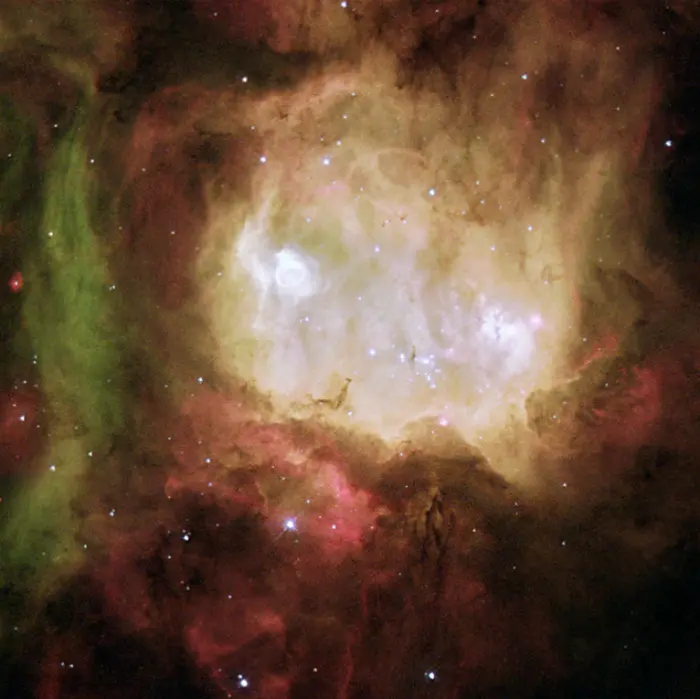
Looking like a colorful holiday card, this image from NASA’s Hubble Space Telescope reveals a vibrant green and red nebula far from Earth, where nature seems to have put on the traditional colors of the season. These colors, produced by the light emitted by oxygen and hydrogen, help astronomers investigate the star-forming processes in nebulas such as NGC 2080. NGC 2080, nicknamed “The Ghost Head Nebula,” is one of a chain of star-forming regions lying south of the 30 Doradus nebula in the Large Magellanic Cloud that have attracted special attention. These regions have been studied in detail with Hubble and have long been identified as unique star-forming sites. 30 Doradus is the largest star-forming complex in the whole local group of galaxies. The light from NGC 2080, the nebula captured in this image, is emitted by two elements, hydrogen and oxygen. The red and the blue light are from regions of hydrogen gas heated by nearby stars. The green light on the left comes from glowing oxygen. The energy to illuminate the green light is supplied by a powerful stellar wind (a stream of high-speed particles) coming from a massive star just outside the image. The white region in the center is a combination of all three emissions and indicates a core of hot, massive stars in this star-formation region. The intense emission from these stars has carved a bowl-shaped cavity in the surrounding gas. Image credit: ESA, NASA, & Mohammad Heydari-Malayeri (Observatoire de Paris, France) (PD)
The stars in A1 and A2 formed within the last 10,000 years. Their powerful stellar winds – outpourings of material – and intense radiation have begun to carve a bubble in the core of the nebula, but their natal gas clouds still conceal them. These clouds will eventually be eroded away by the radiation of the young stars.
The colours of NGC 2080 are influenced by the dominant emission lines. The young stars in the western portion of the Ghost Head are responsible for colouring this section green due to a dominant oxygen emission line. The energy to illuminate the region comes from a powerful stellar wind of a massive young star. Most of the outskirts appear reddish due to ionized hydrogen. The central portion is pale yellow due to the presence of ionized hydrogen and oxygen.
The area around A1 and A2 appears bluish white (mostly white) due to hydrogen gas that is excited enough to emit a second wavelength of light. The bright areas that mark the ghost’s eyes are hot, glowing blobs composed of hydrogen and oxygen.
The Ghost Head Nebula belongs to the Large Magellanic Cloud (LMC), a satellite galaxy of the Milky Way. The Large Magellanic Cloud is one of the nearest galaxies to our own, along with the disputed Canis Major Dwarf (the Canis Major Overdensity) in the constellation Canis Major and the Sagittarius Dwarf Spheroidal Galaxy in Sagittarius.
The Large Magellanic Cloud occupies about 10 degrees of the apparent sky and is easily visible from areas without too much light-pollution. The dwarf galaxy has an apparent diameter 20 times that of the full Moon. The Tarantula Nebula, a H II region just north of the Ghost Head Nebula, is the largest star-forming region in the Local Group of galaxies. It hosts some of the most massive and most luminous stars known.
The Ghost Head Nebula is one of the several star-forming regions south of the Tarantula. Others include the young open clusters NGC 2085, NGC 2086, and NGC 2077. Like the Ghost Head, these clusters are part of the larger emission nebula called LHA 120-N 160.
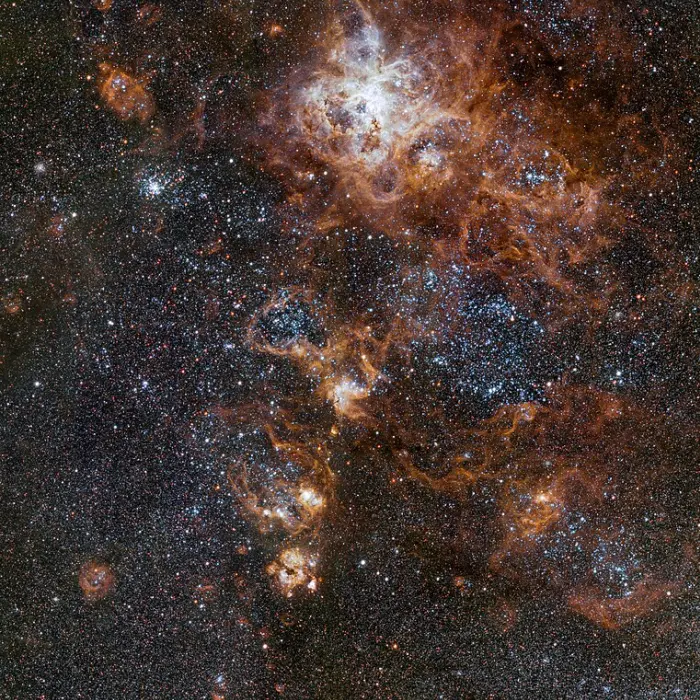
The Tarantula Nebula (30 Doradus) and the Ghost Head Nebula (NGC 2080) – Glowing brightly about 160 000 light-years away, the Tarantula Nebula is the most spectacular feature of the Large Magellanic Cloud, a satellite galaxy to our Milky Way. This image from VLT Survey Telescope at ESO’s Paranal Observatory in Chile shows the region and its rich surroundings in great detail. It reveals a cosmic landscape of star clusters, glowing gas clouds and the scattered remains of supernova events. Image credit: ESO (CC BY 4.0)
Facts
The Ghost Head Nebula was discovered by the English astronomer John Herschel on December 23, 1834. Herschel spent several years (1834 – 1838) cataloguing the southern sky from South Africa. His survey of the southern celestial hemisphere extended and completed the systematic deep sky survey of the northern celestial hemisphere first undertaken by his father William Herschel from 1790 to 1802. The Herschels’ discoveries served as the basis for the New General Catalogue of Nebulae and Clusters of Stars, edited by Danish astronomer John Louis Emil Dreyer and published in 1888.
The Ghost Head may have been spotted by the Scottish astronomer James Dunlop from the Parramatta Observatory near Sydney, Australia, in 1826, but Herschel is usually credited for the discovery.
The Ghost Head Nebula bears a passing resemblance to the Skull and Crossbones Nebula (NGC 2467), a larger spooky-eyed star-forming region in the constellation Puppis, and is one of the several ghost-like nebulae in the sky. It should not be confused with the Ghost Nebula (Sh2-136), a reflection nebula in the constellation Cepheus, nor with the Little Ghost Nebula (NGC 6369), a planetary nebula in Ophiuchus.
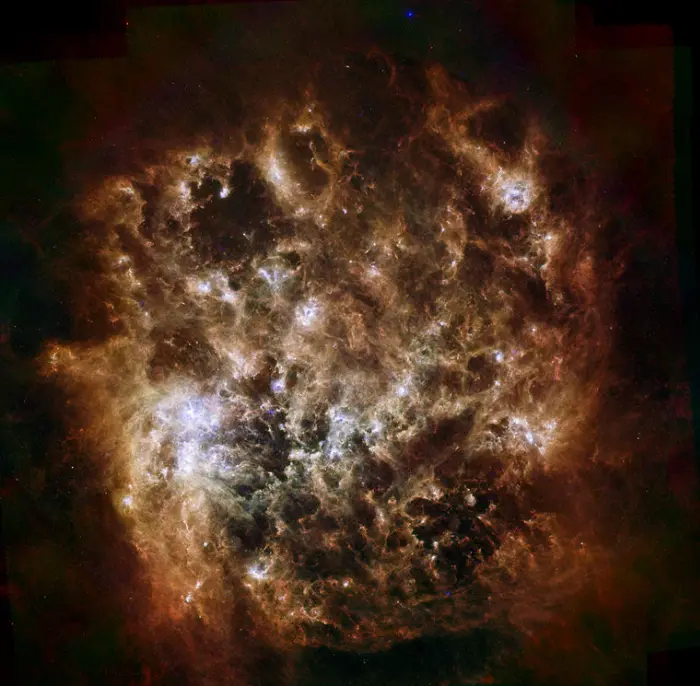
This image shows the Large Magellanic Cloud galaxy in infrared light as seen by the Herschel Space Observatory, a European Space Agency-led mission with important NASA contributions, and NASA’s Spitzer Space Telescope. Significant fields of star formation are noticeable in the center, just left of center and at right. The brightest center-left region is called 30 Doradus, or the Tarantula Nebula, for its appearance in visible light. The colors in this image indicate temperatures in the dust that permeates the Cloud. Colder regions show where star formation is at its earliest stages or is shut off, while warm expanses point to new stars heating the surrounding dust. The coolest areas and objects appear in red, corresponding to infrared light taken up by Herschel’s Spectral and Photometric Imaging Receiver at 250 microns, or millionths of a meter. Herschel’s Photodetector Array Camera and Spectrometer fills out the mid-temperature bands, shown here in green, at 100 and 160 microns. The warmest spots appear in blue, courtesy of 24- and 70-micron data from Spitzer. Image credit: ESA/NASA/JPL-Caltech/STScI (PD)
Location
The Ghost Head Nebula lies in the southern constellation Dorado. The nebula’s host galaxy, the Large Magellanic Cloud, is visible to the unaided eye on a clear night. It can be found using Sirius and Canopus, the brightest stars in the sky. A line drawn from Sirius through Canopus leads to the LMC.
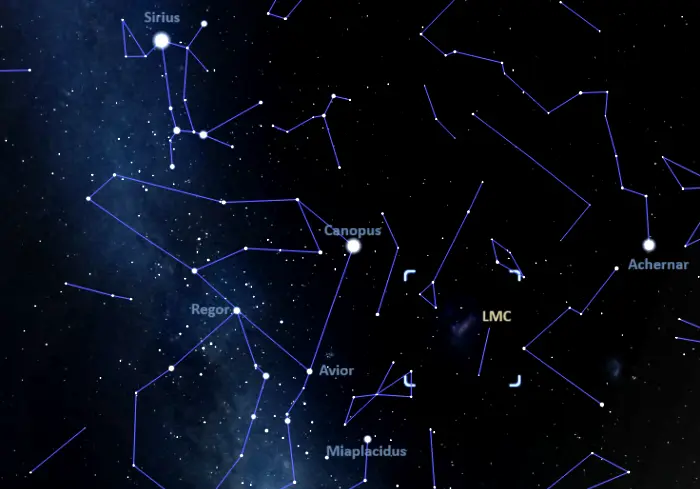
The location of the Large Magellanic Cloud (LMC), image: Stellarium
The Ghost Head Nebula appears just south of the brighter and larger Tarantula Nebula (30 Doradus).
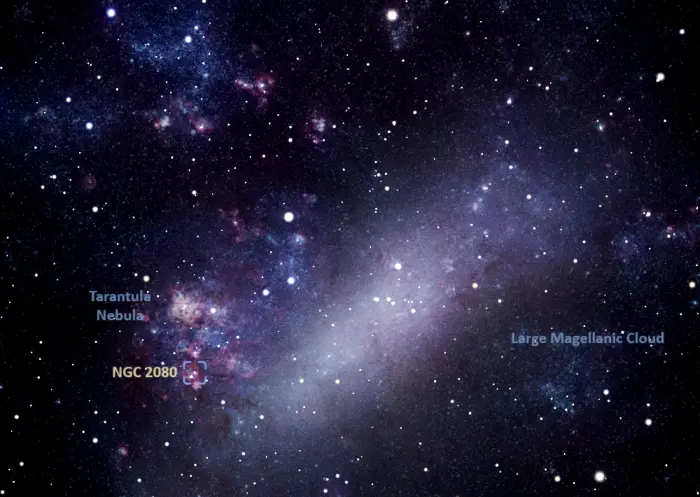
The location of the Ghost Head Nebula in the Large Magellanic Cloud (LMC), image: Stellarium
At declination −69° 39′, the Ghost Head never rises for observers in the mid-northern latitudes. It is visible from locations south of the latitude 20° N, but it never rises high above the horizon for observers in the northern tropical latitudes.
The best time of the year to observe the Ghost Head Nebula, the Large Magellanic Cloud, and other deep sky objects in Dorado is during the month of January, when the constellation appears higher in the sky in the early evening.
Ghost Head Nebula – NGC 2080
| Constellation | Dorado |
| Object type | Emission nebula, H II region |
| Right ascension | 05h 39m 42.6s |
| Declination | −69° 38′ 50″ |
| Apparent magnitude | 10.42 |
| Apparent size | 0.97 x 0.97 arcminutes |
| Diameter | 50 light-years |
| Distance | 160,000 light-years |
| Names and designations | Ghost Head Nebula, NGC 2080, ESO 057-EN012, GC 1278, h 2950, LHA 120-N 160A, LI-LMC 1503, CPD-69 475s, MRC 0540-696, MRC 0540-696B, PKS 0540-695, PKS 0540-696, PKS J0539-6938, SUMSS J053942-693850 |